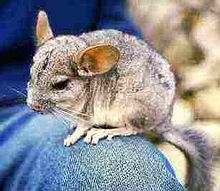Talk:Long-tailed chinchilla
| This article is rated C-class on Wikipedia's content assessment scale. It is of interest to the following WikiProjects: | |||||||||||||||||||||
| |||||||||||||||||||||
Wiki Education Foundation-supported course assignment
![]() This article was the subject of a Wiki Education Foundation-supported course assignment, between 22 January 2019 and 2 May 2019. Further details are available on the course page. Student editor(s): Naiwen Xu.
This article was the subject of a Wiki Education Foundation-supported course assignment, between 22 January 2019 and 2 May 2019. Further details are available on the course page. Student editor(s): Naiwen Xu.
Above undated message substituted from Template:Dashboard.wikiedu.org assignment by PrimeBOT (talk) 02:49, 17 January 2022 (UTC)
About the Chinchilla lanigera authority
NCBI Taxon Browser is listing Molina, not Bennett (http://www.ncbi.nlm.nih.gov/Taxonomy/Browser/wwwtax.cgi?mode=Info&id=34839&lvl=3&p=mapview&p=has_linkout&p=blast_url&p=genome_blast&lin=f&keep=1&srchmode=1&unlock) Trurl66 07:13, 24 June 2007 (UTC)
- Woods and Kilpatrick (2005) in Mammal Species of the World Vol. 3 say: "Osgood (1941) critically reviewed the early descriptions of chinchillas and suggested that Molina's (1782) Mus laniger was a composite based on no known specimens. Bennett (1829) used Chinchilla lanigera, derived from Molina's Mus laniger, without stating that the animal described is the same as that described by Molina (1782)." --Aranae 20:48, 24 June 2007 (UTC)
Wild vs. domesticated Chinchilla
In reply to this:
There is a vast difference between them. Please, at the very least, Google them before making such false claims. The wild Chinchilla lanigera species is much smaller than it's domesticated counterpart and it's form has quite a bit of variation. In fact, the wild version looks more like a mouse or a chipmunk than it does a domestic chinchilla. The article that is specifically about the wild Chinchilla lanigera should strictly contain pictures of the wild Chinchilla lanigera. I don't think there would be a problem with a section within the article that talks about the domesticated version a bit and has a picture of a domesticated chinchilla there, but the pictures should predominately be composed of wild chinchillas only and, if they aren't, they should be labeled as such. Otherwise, you're giving people the false impression that the few that are romping around in the wild look just like the fuzzballs in their living room, which they don't. --74.137.227.117 18:25, 28 July 2007 (UTC)
Could you please substantiate your claim that there is a "vast" difference in appearance between wild and domesticated Ch.l. (yes, I googled them, and no, wild chinchillas do not look anything like mice or chipmunks). I strongly disagree that this article is specifically about wild Ch.l. - this article is about a species Chinchilla lanigera no matter domesticated or not. I agree however that images of wild specimens should be included in this article and I greatly appreciate if you or anyone else can provide those images.
- Can you cite the fact that there are domesticated and wild varients of Chinchilla chinchilla?, and experts call one "dometic(ated)" animal? If so, should this article be split? If the artical can't be split, can a strong devision be created with the article sections to make this clear? Chrisrus (talk) 03:57, 17 August 2012 (UTC)
Important to differentiate in the article
This is key to improving the article. I was wondering if the domesticated chinchilla is a subspecies of C. lanigera. 76.102.7.183 (talk) 20:09, 11 March 2019 (UTC)
What is wrong with this image?
@El C:

2601:647:CB02:5034:A9D9:C859:43B3:99D4 (talk) 20:45, 11 April 2019 (UTC)
- It's clearly of lower quality than the current one. El_C 21:21, 11 April 2019 (UTC)
- If not in the box, it needs to be added somewhere to the article as the only picture of a wild chinchilla. 2601:647:CB02:5034:A9D9:C859:43B3:99D4 (talk) 21:51, 11 April 2019 (UTC)



